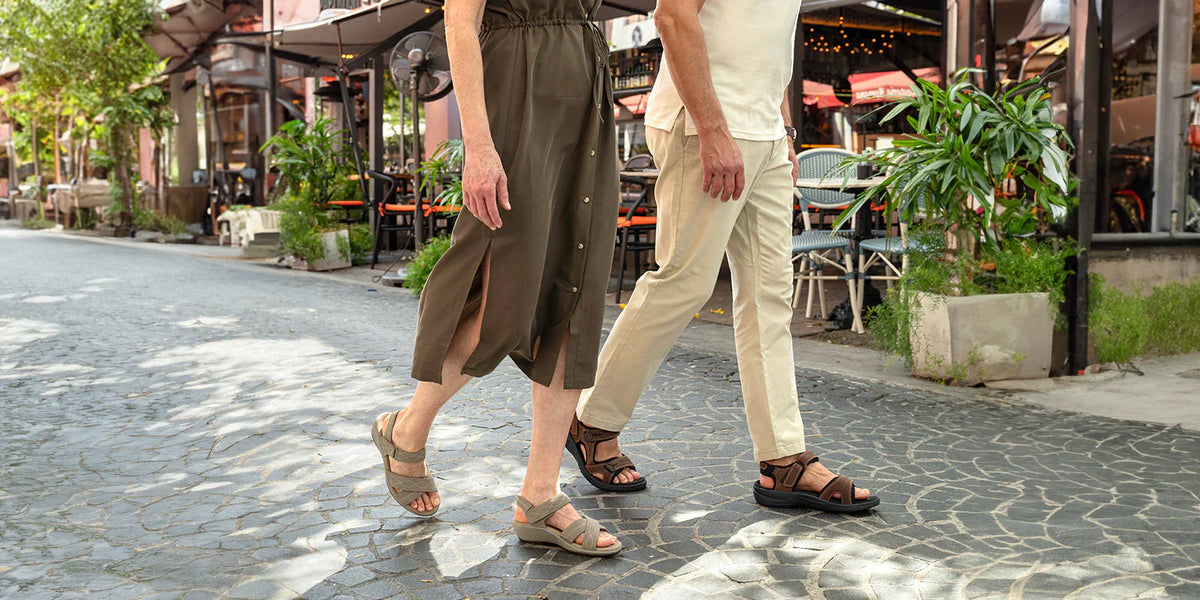The Orthofeet Blog
- All Posts
- All
- Arch Support
- Back Pain
- Bunion
- Diabetes
- Flat Feet
- Foot Pain
- Heel Pain
- Heel Spurs
- Hip Pain
- Knee Pain
- Plantar Fasciitis
- Swollen Feet

Vincent Lin / October 21, 2025
Can Stress Cause Burning Feet? Understanding the Connection
Can Stress Cause Burning Feet? Understanding the Connection
Read Post
Popular Articles
EXPERT CONTRIBUTORS
-
Understanding the Differences: Collapsed Arch vs Flat Feet
Medical information provided by Orthofeet Team / June 06, 2025Introduction to foot arch problems Your feet are the foundation of your body, but sometimes that foundation cracks. Foot deformity problems, like flat feet and fallen arches, aren’t just a pain point—they can throw off your whole-body balance and cause different issues. Normally, your foot has a built-in shock absorber: the arch. This curve is a team effort, with muscles, ligaments, and tendons working together. The posterior tibial tendon is especially crucial as it provides the main support for the arch. When this support system weakens, the arch can start to sag or disappear completely [1]. This can lead to flat feet or collapsed arches. Although you can use these terms interchangeably, they're different conditions. Flat feet are like a birthmark – you’re born with them. Collapsed arches are more of a process, developing over time. Understanding the differences between a collapsed arch vs flat feet is crucial for proper diagnosis and treatment. So, let’s get to know each condition better. What are flat feet? Congenital flat feet, also known as pes planus, form when the arches of the feet do not develop properly from childhood. This condition, present from birth, can lead to an improper formation of the foot arch. While flat feet often do not cause immediate issues, they can result in discomfort and other complications as you get older [2]. This is particularly relevant when considering how your feet impact knee pain and hip pain, as improper foot alignment can transmit undue stress up the kinetic chain, affecting these larger joints and potentially leading to broader musculoskeletal issues. Understanding what causes flat feet helps identify the right interventions and whether flat feet shoes for women or flat feet shoes for men might be necessary. Signs and symptoms of flat feet Flat feet can show up in various ways that might impact your daily life. Here are some common signs to watch out for: Easily tired feet If you’ve got flat feet, you might notice your feet getting tired quickly after standing or walking for a long time [2]. Arch or heel pain Pain in your arch or heel, especially after being active, is a common issue with flat feet [2]. Swollen feet You might experience swelling around the inside of your ankle or in your feet, especially after being on your feet for a while [2]. Difficulty moving the foot Flat feet can make it harder to move your feet smoothly, leading to stiffness or less mobility [2]. Back and leg pain The way your feet align, or misalign in this case, can impact your legs and lower back, leading to discomfort and affecting your posture and the way you walk [2]. Visible arch changes in children In young kids, flat feet might look like flexible flat feet, where the arch shows up when they’re on their tiptoes but disappears when they’re flat on the ground. This usually improves as they grow [1]. Challenges in physical activities Engaging in physical activities can be particularly challenging for those with flat feet due to improper foot alignment, which can cause increased discomfort and reduce efficiency. This is especially evident in activities like running with flat feet, where the lack of proper arch support can lead to faster fatigue and a higher risk of injury. Causes of flat feet Flat feet can form from a mix of genetic and developmental factors. Genetic factors Flat feet are often something you’re born with. This condition can be inherited and happens because the arches don’t develop as they should [2]. Developmental factors As mentioned earlier, flexible flat feet are pretty common in young children. When they stand, their feet might look flat, but you’ll see a bit of an arch when they go on their toes. Usually, the arches form properly as they grow [1]. What are collapsed arches? Now, let’s look at collapsed arches vs flat feet. Flat feet from collapsed arches, also known as fallen arches or acquired flatfoot, are different from congenital flat feet because they develop later in life. Instead of being present from birth, collapsed arches happen due to weakening or damage to the tendons that support the foot’s arch. Signs and symptoms of collapsed arches You might notice several signs if you have collapsed arches, such as: Pain along the bottom of your foot and in the ankle, especially after being active [1]. Trouble standing on tiptoes or a noticeable flat appearance of your feet. Heel and arch pain similar to plantar fasciitis, along with swelling in the ankle. Uneven wear on your shoes, and blisters or calluses from shoes that don’t fit well [1]. Causes of collapsed arches According to Dr. Josh White, DPM, “One of the main causes of collapsed arches is posterior tibial tendon dysfunction.” He explains that the tibialis posterior is a muscle in the lower leg. “The tendon from this muscle runs behind the inside bone on the ankle, across the instep, and attaches to the bottom of the foot. It helps hold up the arch and stops the foot from rolling over. Sometimes, this tendon gets stretched and inflamed, leading to a condition called posterior tibial tendon dysfunction (PTTD) or acquired adult flatfoot. Most people just call this condition fallen arch or collapsed arches.” Collapsed arches can also be caused by: Injury or wear and tear Overuse, injuries, or chronic stress on the foot can weaken the arch. Health conditions Issues like rheumatoid arthritis, nerve problems, obesity, diabetes and even pregnancy can increase the risk of collapsed arches. Age As you get older, the tendons that support your arch may lose strength and elasticity, leading to a collapse over time. Diagnosing flat feet and collapsed arches Spotting the signs of collapsed arch vs flat feet and getting the right treatment is key to keeping your feet healthy. Pain along the inside of your foot and ankle, especially near the posterior tibial tendon, is a common sign, particularly if it gets worse with high-impact activities. You might also feel pain on the outside of your ankle due to the heel bone shifting outward when the arch collapses, often with swelling in the area [3]. To medically diagnose flat feet, doctors follow a few steps to understand how your feet are working, why you might be having problems, and what factors are contributing to your condition. Physical examination Observation Your healthcare provider will check your feet while standing and sitting, looking for a flat arch that appears when you stand but disappears when you’re off your feet. They’ll also look for overpronation, such as the ‘too many toes’ sign, and compare both feet for differences [3]. Touch assessment The doctor will gently press on different parts of your feet to find any tenderness or unusual findings [3]. Flexibility check The doctor will move your foot around to see if your flat feet are flexible or stiff [3]. Muscle strength evaluation You might be asked to do exercises like standing on your toes so the doctor can assess the strength of the muscles that support your arch [3]. Walking analysis How you walk can give clues about your foot condition. The doctor will look for signs of overpronation or limping that might point to underlying issues [3]. Imaging tests If the physical exam doesn’t give a clear picture, you might need additional imaging tests: X-rays These images show the structure of your foot bones and can help spot any skeletal problems. CT scans CT scans offer detailed views of your bones and joints, useful for diagnosing more complex issues. MRI scans MRI scans provide detailed images of soft tissues like tendons and ligaments, showing problems not visible in other scans. Electromyography (EMG) This test checks the health of your muscles and the nerves controlling them, helping to identify any nerve-related issues [2]. Treatment Options Non-surgical treatments For many people, non-surgical methods can effectively manage both flat feet and collapsed arches, and help prevent further issues. Supportive shoes and orthotics Wearing a well-fitted, supportive shoes can make a big difference in comfort. Extra Wide shoes and shoes for flat feet can provide relief, especially if you’re experiencing pain. Custom arch supports and orthotics help spread pressure evenly across your feet and improve alignment. They can also boost your gait and balance [2][4]. Physical therapy Physical therapy is a great way to ease pain and boost foot flexibility. Tailored exercises and stretches can strengthen weak muscles and enhance balance, targeting the specific needs of your condition [3]. Weight management If weight is a factor, adopting a healthy diet and regular exercise can help take pressure off your arches and improve symptoms. Losing weight can significantly reduce the strain on your feet [3]. Surgical interventions If non-surgical treatments don’t do the trick or if the condition is severe, surgery might be an option. Children Surgery for children with flat feet is usually only considered if they have a more rigid form of the condition that doesn’t improve with other treatments. In such cases, surgery might be needed to fix the structural issues [3]. Adults For adults with severe flat feet or conditions like posterior tibial tendon dysfunction that don’t respond to non-surgical treatments, surgery might be recommended. Surgical options can range from separating fused bones (if that’s the cause) to repairing damaged tendons and ligaments [2][3]. Prevention and management There are ways to help keep flat feet and collapsed arches from getting worse and to manage them. Here are some tips, including advice from Dr. White. Recognize the symptoms early Sharp, burning pain in the arch and heel. Swollen ankles. Difficulty standing on tiptoes, jumping, or running. Pain in the calf, knee, or lower back. Perform arch-strengthening exercises Dr. White says foot exercises for flat feet are aimed at strengthening the arches and can help prevent collapsed arches. Here are a couple of examples he suggests: Wrap a towel around the sole of your foot, extend your leg, and hold for 30 seconds. Stand barefoot on a hard surface, flex your feet to activate the arch muscles without rolling your feet or pressing down your toes. Wear proper footwear Choose sturdy shoes that help stabilize the foot. Ensure shoes can accommodate orthotic insoles and braces. Use supportive orthotic insoles Orthotics help support the arches and compensate for overpronation. These insoles help distribute weight more evenly across the foot, reducing strain and pain. As Dr. White suggests, "Wearing proper foot orthotics and fallen arches insoles, together with fallen arches shoes, can help reduce strain on the posterior tibial tendon and alleviate pain and inflammation." How to choose the right shoes Choosing the right shoes is key for managing flat feet and collapsed arches. Dr. White points out the features to look for. Premium orthotic insoles Shoes with good orthotic insoles provide solid arch support, helping to align your feet properly and reduce overpronation. This is crucial for keeping your foot structure and function in check. Firm heel counter A firm heel counter is important because it keeps your heel in place and gives extra support to your foot. It helps cut down on overpronation and eases strain on your foot. Supportive soles Make sure the soles of your shoes offer firm support and don’t collapse under your arch. Supportive soles help keep your foot's natural shape and prevent your arch from flattening further. Extra depth design Shoes with extra depth give a more relaxed fit, allowing for better toe movement and fitting custom orthotics. This feature is especially useful if you need more space because of foot conditions or orthotic inserts. Removable insoles Shoes with removable insoles are great because if you need custom orthotics you can easily swap them out. This customization makes it easier to address specific foot issues. Stretch uppers As flat feet can lead to overpronation, this increases pressure on the foot and can cause bunions and corns. A flexible upper material adapts to the foot's unique shape, reducing pressure and friction on sensitive areas. This helps alleviate discomfort and prevent further irritation. ================= [1] Beth Roybal (medically reviewed by Carol DerSarkissian, MD). What Are Fallen Arches?. WebMD. January 12, 2023. Accessed July 24, 2024. https://www.webmd.com/pain-management/what-are-fallen-arches [2] Adam Felman (medically reviewed by Adam Hotchkiss, DPM). What To Know About Flat Feet. Medical News Today. Updated January 12, 2024. Accessed July 21, 2024. https://www.medicalnewstoday.com/articles/168608 [3] Marc A. Raj, Dawood Tafti, John Kiel. Pes Planus. National Library of Medicine. Updated May 23, 2023. Accessed July 21, 2024. https://www.ncbi.nlm.nih.gov/books/NBK430802/ [4] Ewa Bednarczyk, Szymon Sikora, Aneta Kossobudzka-Górska, Krzysztof Jankowski, Yunuhen Hernandez-Rodriguez. Understanding Flat Feet: An In-Depth Analysis Of Orthotic Solutions. Science Direct. March 2024. Accessed July 2024. https://www.sciencedirect.com/science/article/pii/S2773157X23001224#bib5Read More





